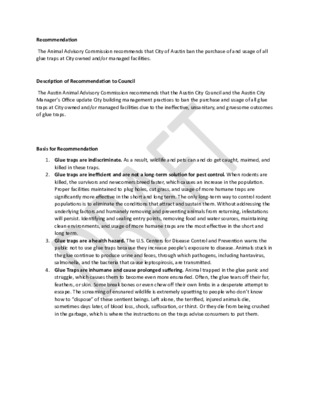Item 7 - Glue Trap Ban Draft Recommendation — original pdf
Backup

Recommendation The Animal Advisory Commission recommends that City of Austin ban the purchase of and usage of all glue traps at City owned and/or managed facilities. Description of Recommendation to Council The Austin Animal Advisory Commission recommends that the Austin City Council and the Austin City Manager’s Office update City building management practices to ban the purchase and usage of all glue traps at City owned and/or managed facilities due to the ineffective, unsanitary, and gruesome outcomes of glue traps. Basis for Recommendation killed in these traps. 1. Glue traps are indiscriminate. As a result, wildlife and pets can and do get caught, maimed, and 2. Glue traps are inefficient and are not a long-term solution for pest control. When rodents are killed, the survivors and newcomers breed faster, which causes an increase in the population. Proper facilities maintained to plug holes, cut grass, and usage of more humane traps are significantly more effective in the short and long term. The only long-term way to control rodent populations is to eliminate the conditions that attract and sustain them. Without addressing the underlying factors and humanely removing and preventing animals from returning, infestations will persist. Identifying and sealing entry points, removing food and water sources, maintaining clean environments, and usage of more humane traps are the most effective in the short and long term. 3. Glue traps are a health hazard. The U.S. Centers for Disease Control and Prevention warns the public not to use glue traps because they increase people’s exposure to disease. Animals stuck in the glue continue to produce urine and feces, through which pathogens, including hantavirus, salmonella, and the bacteria that cause leptospirosis, are transmitted. 4. Glue Traps are inhumane and cause prolonged suffering. Animal trapped in the glue panic and struggle, which causes them to become even more ensnarled. Often, the glue tears off their fur, feathers, or skin. Some break bones or even chew off their own limbs in a desperate attempt to escape. The screaming of ensnared wildlife is extremely upsetting to people who don’t know how to “dispose” of these sentient beings. Left alone, the terrified, injured animals die, sometimes days later, of blood loss, shock, suffocation, or thirst. Or they die from being crushed in the garbage, which is where the instructions on the traps advise consumers to put them.